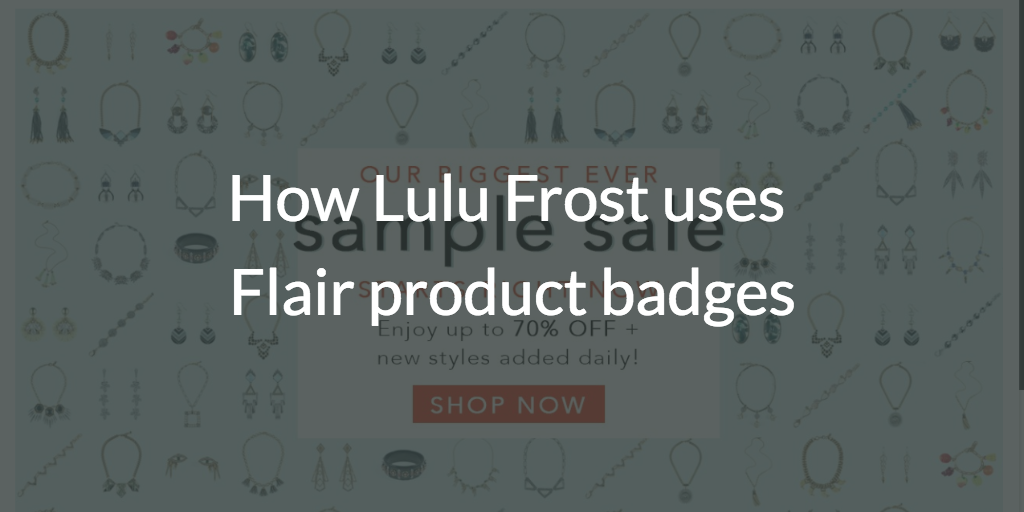How To Cross-Sell on Shopify in 2025: Expert Tips & Strategies

When a customer visits your Shopify store and finds a product they love, your only job is to help them breeze through the checkout process as quickly as possible, right?
Not necessarily.
Sure, you want to provide a seamless, enjoyable user experience. But you also want to extract the maximum possible value from each and every transaction.
That’s where cross-selling comes in.
In this guide, we’re going to walk you through the basics of cross-selling, then help you boost your average order value by sharing our favorite strategies, best practices, and tools.
Let’s get into it…
What Is Cross-Selling?
Cross-selling is an e-commerce strategy that encourages customers to spend more money by recommending additional items related to the one they were originally planning to purchase.
Those additional items might:
- Complement the original product in some way (like recommending custom laces with a new pair of sneakers)
- Enhance its functionality (like recommending a longer lens with a new camera)
- Protect it (like selling a phone case alongside a new mobile phone)
Whatever approach you take, the goal of cross-selling is always to generate more revenue by increasing the number of products in the customer’s shopping cart.
Cross-Selling vs Upselling: What's the Difference?
“Upselling” is often used as a blanket term for all e-commerce strategies that encourage customers to spend more of their hard-earned cash.
But while their goals might be the same, cross-selling and upselling are very different beasts:
- Cross-selling encourages shoppers to purchase more items in a single transaction
- Upselling persuades them to upgrade to a more expensive version of the product they were planning to buy
Pro tip: Looking for upsell app recommendations? Check out our guide: Best Shopify Upsell Apps.
To better illustrate the differences between these two strategies, let’s look at a real-world example from the Adidas online store:

Adidas drives upsells by encouraging customers thinking of buying their Samba Classic sneaker to instead purchase one of the premium versions featured in the You May Also Like section.

Pro tip: For more product page conversion tips check out our guide: Maximize Conversions: Optimize Your Shopify Product Pages.
While also promoting cross-sells by persuading customers to Complete the Look — which, unsurprisingly, involves buying one or more related products:
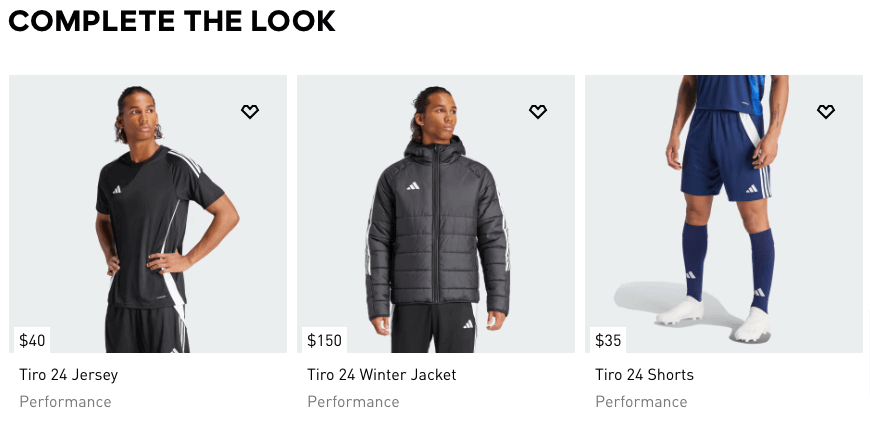
This example proves that upselling and cross-selling shouldn’t exist in isolation.
For best results (i.e. more sales and revenue), you should promote both cross-sells and upsells to every potential customer who visits your store.
Pro tip: Learn more about upselling in our guide: How To Upsell on Shopify.
What Are the Benefits of Cross-Selling?
The whole point of cross-selling is to earn more money. But let’s take a closer look at the specific benefits:
- Cross-selling is cheaper than acquiring a new customer. The average e-commerce customer acquisition cost grew by 222% from 2013 – 2022. So it’s more cost-effective to sell three products to a single customer than one item each to three different customers.
- Cross-selling helps you grow sustainably. By reducing your reliance on customer acquisition, cross-selling strategies set up your store for sustained, long-term growth.
- Cross-selling makes customers happy (theoretically). Recommending high-quality complementary products gives customers more value from their purchases, so they feel more satisfied. Of course, this only works if they actually like the items you cross-sold them.
8 Cross-Selling Strategies
Cross-selling is an open goal for Shopify merchants. If you’re not cross-selling effectively, you’re massively limiting your growth potential.
Here are eight tried-and-trusted strategies to help you get it right:
Promote Cross-Sells on Product Pages
If you only use one cross-selling strategy (which you shouldn’t), let it be this: adding complementary items to your product pages.
When customers click through to a product page, it’s a fair indication that they’re at least somewhat interested in the product in question. Which makes it far easier to recommend other related products they might love.
For example, sustainable lifestyle brand Package Free use this laundry detergent product page…
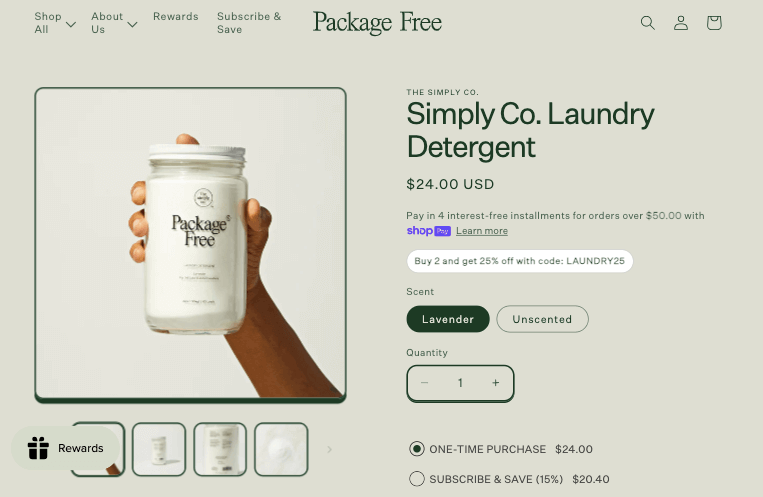
…to steer customers toward a bunch of other laundry products:
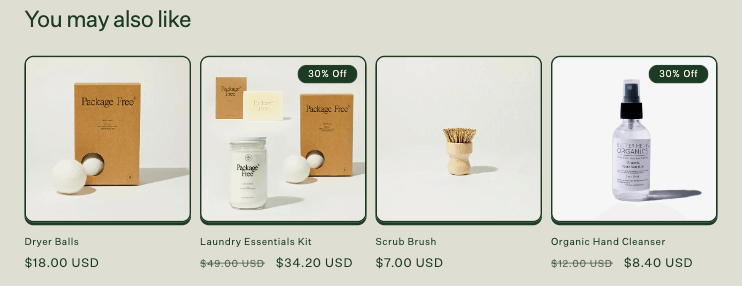
Not only is this strategy effective, but it’s also super easy to implement.
Pro tip: Learn how to create and customize product recommendations in this Shopify guide.
Offer Free Shipping To Boost Transaction Value
Another simple-but-effective way to boost cross-sells is to give customers a clear incentive for buying more stuff.
That incentive could be anything from a free gift to extra loyalty points to price discounts. But research published in the International Journal of Electronic Commerce Studies suggests free shipping offers work better than dollar-off discounts for lower-priced purchases.
Cosmetics brand Duradry is evidently aware of this.
They use the promise of free shipping on $30+ orders to coax customers into buying additional products once they’ve added an item to their shopping cart:
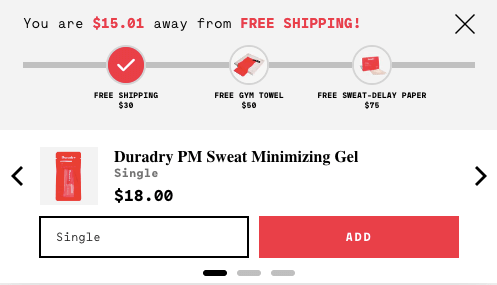
Cleverly, as you can see, they also offer three potential (and highly relevant) cross-sell options on the same screen.
Cross-Sell Based On In-Cart Items
Think about it:
There’s no greater signal of “buying intent” than a customer adding a product to their shopping cart.
So, it makes perfect sense to cross-sell based on in-cart items.
Flower delivery brand Bloom & Wild knows that most of their customers are buying flowers for someone else (to celebrate an anniversary or achievement, offer condolences for bad news, or just because).
So they use this tactic to promote products that would complement your flower order by making your gift feel even more special:
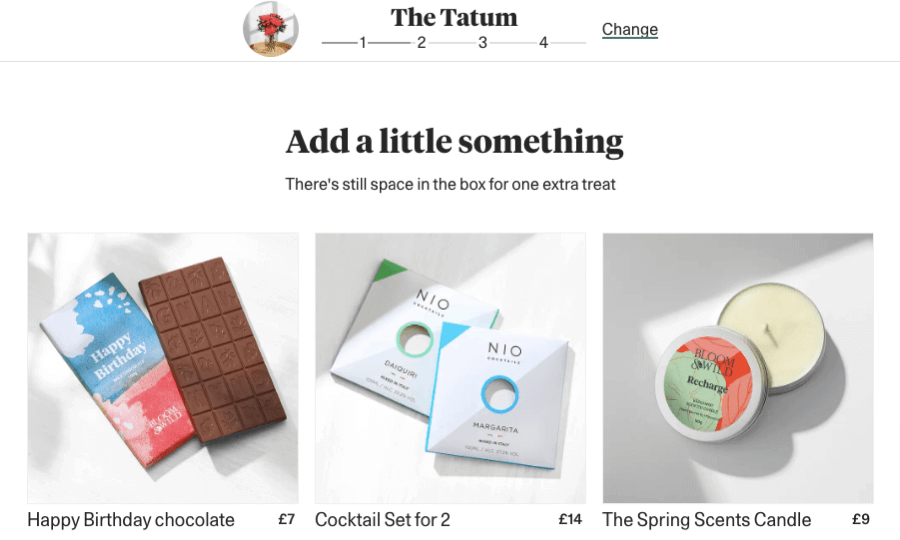
That way, the customer gets to feel like a brilliant person and Bloom & Wild makes more money. Everyone wins!
Use Eye-Catching Popups To Cross-Sell Related Products
Targeting store visitors with popups is one of our favorite cross-selling strategies, with the average popup achieving a conversion rate of 3.1% (and the top one-tenth of popups converting at an impressive 9.3%).

In our view, the best way to use popups to drive cross-sells is to display them immediately after a customer adds an item to their shopping cart.
Because, as we’ve already noted, that’s when they’re most likely to buy.
Personal care brand Harry’s uses this tactic to showcase related products, such as promoting face lotion and beard care products alongside a pack of razor blades:
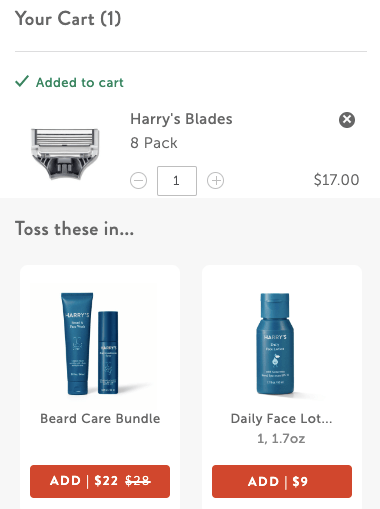
This cross-sell popup strikes the right balance by steering shoppers toward additional products they might like without interrupting the path to purchase.
Smart stuff!
Share Cross-Sells in Post-Purchase Emails
Speaking of disrupting the customer’s journey, one way to guarantee this doesn’t happen is to wait until they’ve already bought something before hitting them with a cross-sell offer.
How? By sending them a post-purchase cross-sell email.
There’s solid logic behind this approach.
Order confirmation emails see one of the highest open rates of any type of e-commerce email:
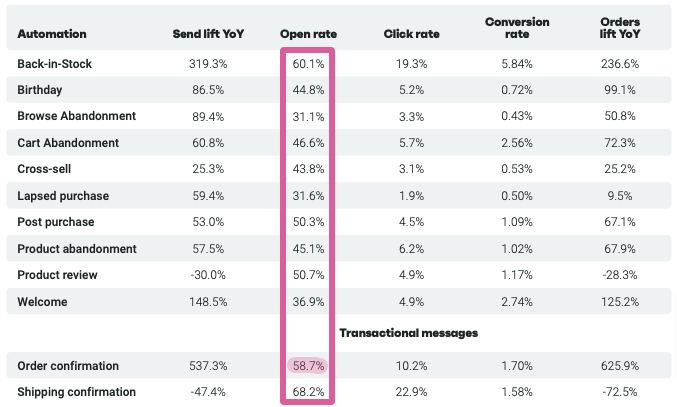
So, if you know most customers will open those emails, why wouldn’t you use them to recommend a cross-sell or two?
Creating high-converting post-purchase cross-sell emails is a simple, repeatable process:
- Thank the customer for their purchase
- Remind them exactly what they bought
- Use dynamic tagging to recommend products that complement their purchase
Furniture brand Crate & Barrel gets this right by adding a bunch of cross-sell options at the bottom of their order confirmation emails:
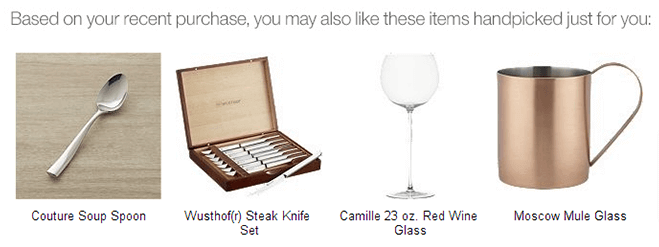
Notice how they don’t list the price. So, if you like the look of one of those items, you’ll have to click through to their website to learn more.
Cross-Sell on Your Thank You Page
Like the sound of post-purchase cross-sells, but prefer to act before the customer leaves your store?
Thank you page cross-sells are the perfect solution.
In our next example, Laumiere Gourmet Fruits used their thank you page…
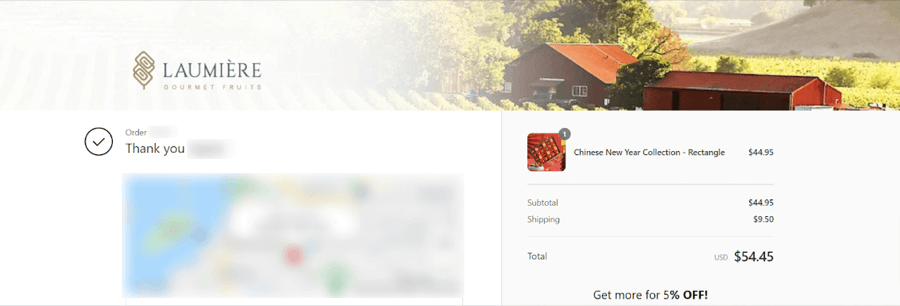
…to promote a bunch of cross-sell options (in this case, various different values of gift cards):
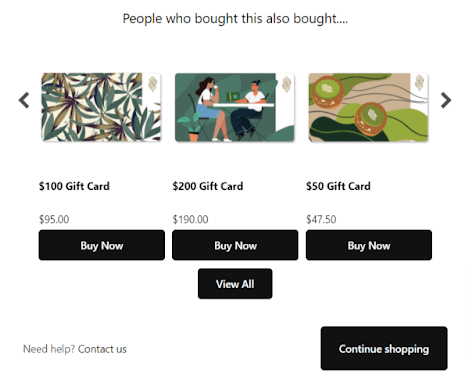
Sure, gift cards aren’t the most inspiring cross-sell.
But this strategy worked wonders, with Laumiere’s thank you page cross-sell offers generating a 7% conversion rate and a 10% uplift in overall revenue.
Create "Shoppable" Imagery
So far, our cross-selling strategies have all been focused on the point when shoppers are either ready to convert or have already bought something.
Let’s rewind and consider a tactic that works anywhere in the buyer’s journey: shoppable images.
These are interactive visual elements that show multiple complementary products being used alongside one another, which makes it easy for customers to understand why they should buy all those products together.
IKEA uses this strategy on their homepage to promote a wide range of products, from wine glasses to bedding to outdoor furniture. Hovering over one of the in-image “hotspots” brings up a box containing the following:
- Product name
- Product category
- Price
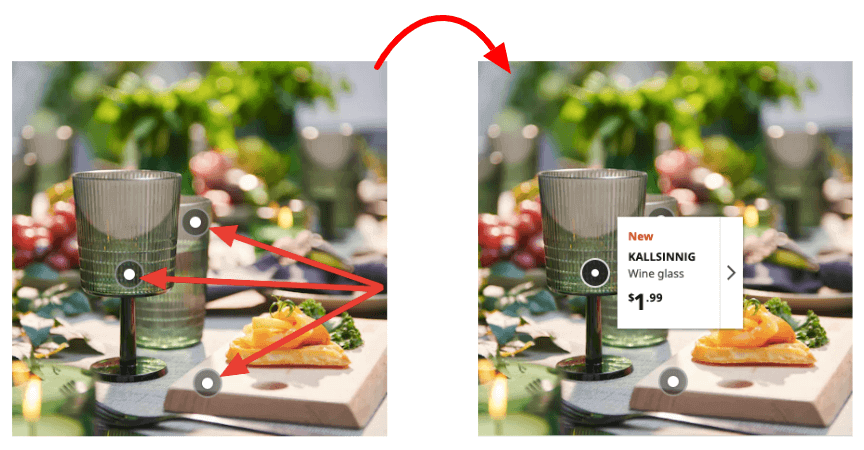
Clicking on the box takes you straight to the relevant product page, where you’ll find the other items from the shoppable image in the Frequently bought together section:
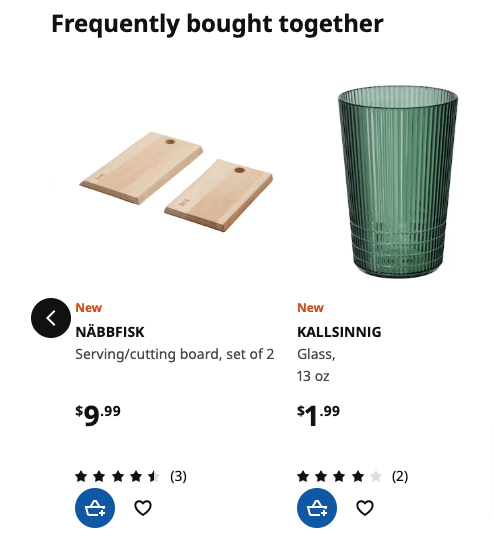
Use Discounts To Encourage Product Bundling
According to HubSpot, product bundling is the most popular cross-selling strategy.
It’s easy to see why.
Bundling 2+ items together and offering them at a discounted rate is a win-win: your customer gets a great deal, and you increase your average order value, average items per transaction, and total revenue.
Chubbies use this strategy to encourage shoppers to purchase more than one of the same type of product (such as multiple pairs of swim trunks) by promoting a $10 price-saving on their product pages:

Then, when you add one qualifying product to your shopping cart, they hit you with a popup showcasing a bunch of other stuff you can buy to unlock the deal:
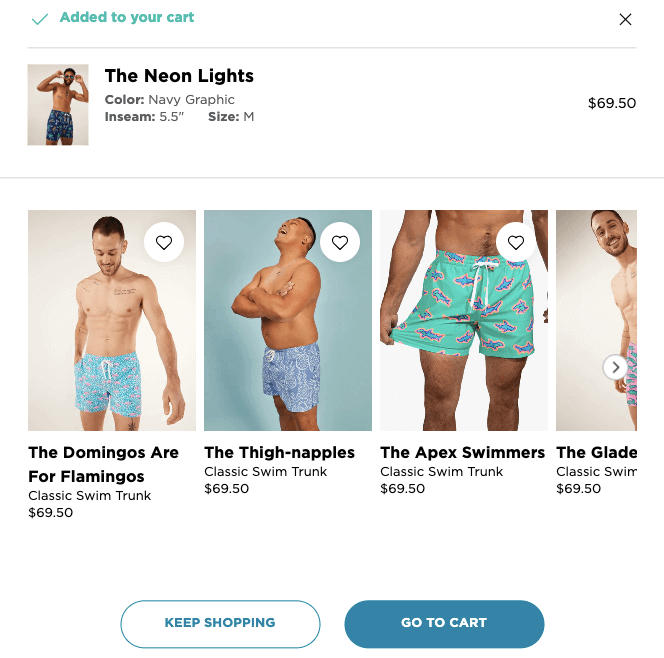
Best Practices for Effective Cross-Selling
We’ve shown you a bunch of smart strategies to boost cross-sells.
But none of those strategies will work if you don’t also follow these cross-selling best practices:
Choose Complementary Products
Want to know the single most important factor in successful cross-selling?
Product relevance.
It doesn’t matter how many perks you offer or how many different cross-sell strategies you use. If the products you recommend aren’t valuable or interesting to your customers, you’re not going to generate any extra sales.
Suggesting relevant, complementary products is mostly a matter of common sense. Your customer just bought a T-shirt — so why not show them a pair of complementary sunglasses or point them toward your baseball cap collection page?
As with most things in the world of e-commerce, your best bet is to try cross-selling a bunch of different product types and see what works best.
Use Sales Data To Identify Cross-Sell Opportunities
Want to take a more data-driven approach to identifying potential cross-sell opportunities?
Try using Shopify’s analytics suite to identify pairs of products that often appear together in customers’ shopping carts.
Here’s how to do it:
- Log into your Shopify admin.
- In the left-hand menu, navigate to Analytics > Reports.

- From the list of reports, click Online store cart analysis to bring up the desired data.

Discovered that customers are constantly adding Product A and Product B to their shopping carts together? They’re clearly a perfect match, so it’s time to promote Product A in Product B’s Frequently Bought Together section (and vice versa).
Bear in mind you won’t see any data if no frequent product pairs were identified in the previous 30 days. This could happen if you:
- Didn’t get enough visitors adding products to shopping carts during the period
- Sell a wide variety of products
- Recently added a bunch of new products to your store
Don't Disrupt the User Journey
Sure, cross-selling is important to the long-term success of your Shopify store.
But if you constantly bombard shoppers with popups and lengthen the checkout process with multiple screens of recommended products and offers, you’re unlikely to see the desired results.
Chances are you’ll just tank your conversion rate.
Ideally, cross-sells should be prominent enough to grab the shopper’s attention, without preventing them from carrying out their desired action (like buying a product).
For that reason, we recommend keeping a close eye on your analytics whenever you introduce a new cross-sell offer or tactic to make sure you aren’t scaring away potential customers.
Use Scarcity and Urgency
Choose the right products and your cross-sell offers should already be pretty compelling.
But you can make them even more persuasive by adding an element of scarcity and/or urgency to your cross-sell promotions.
Short-term offers and low-stock products are like catnip to consumers, with research published in the Journal of the Academy of Marketing Science revealing that limited-edition products enjoy “a rapid jump in demand” during the launch period.
Use this to your advantage by promoting limited-time cross-sell discounts and recommending products that are in short supply.
Pro tip: Find out more in our article: While Supplies Last: 8 Scarcity & Urgency Tactics.
Provide Up To 5 Cross-Sell Options
You might think the more products you recommend, the more likely customers will be to take you up on your cross-sell offer.
But providing too many options can trigger decision overload, which can actually hurt your sales. Over one in six US shoppers say they sometimes feel “overwhelmed by choice”, while one in 10 customers admit they’ve abandoned a transaction because they were shown too many possible purchases.
As a general rule, we’d recommend providing no more than five options at a time. But be sure to run your own A/B tests to see what works best for your audience — you might even find that offering a single complementary product generates the highest conversion rate.
5 Best Shopify Cross-Selling Apps
Shopify’s App Store features over 8,000 different apps, many of which are designed to boost your transaction value through cross-selling.
Here are five of the best options:
| App name | What it does | Price |
| EVM Lookbook | Create shoppable image galleries with clickable hotspots and tags that point shoppers toward featured products. | Free for one gallery. Paid plans start at $4.99 per month for up to four galleries. |
| Bundler | Build a wide range of product bundle types and promote them with free shipping offers, percentage discounts, and more. | Offers a free-for-life plan with basic bundles. Unlock premium options by upgrading to a paid plan, priced from $6.99 per month. |
| ReConvert | Promote cross-sell offers on checkout and post-purchase pages. | Free for development stores. Paid plans start at $4.99 per month. |
| Frequently Bought Together | Let customers purchase related products with a single click, just like on Amazon. | Free for development stores. Paid plans cost $9.99 per month. |
| Cross Sell & Upsell Pro | Offer automated cross-sell recommendations based on related products, recently viewed items, best-selling products, and more. | Forever-free plan offers limited cross-sell options. Access all features for $5.95 per month. |
FAQs
Is upselling the same as cross-selling?
No!
Upselling and cross-selling are both about encouraging customers to spend more money, but they work in slightly different ways.
Cross-selling is about persuading customers to buy multiple products in a single transaction, whereas upselling encourages them to upgrade their planned purchase to a more expensive “premium” version.
What is the best app for cross-selling on Shopify?
There are plenty of options for cross-selling apps on Shopify, with an App Store search for “cross sell” bringing up 930+ results. However, here are five of our favorites:
- Bundler
- Cross Sell & Upsell Pro
- EVM Lookbook
- Frequently Bought Together
- ReConvert
What Is an example of a cross-sell strategy?
An example of a cross-sell strategy is a consumer tech brand recommending a matching phone case to customers buying a new mobile phone. Taking things a step further, the retailer could level up this cross-sell offer by bundling multiple phone accessories together at a discounted rate — think screen protectors, travel chargers, maybe even a selfie stick (do people still buy those?).
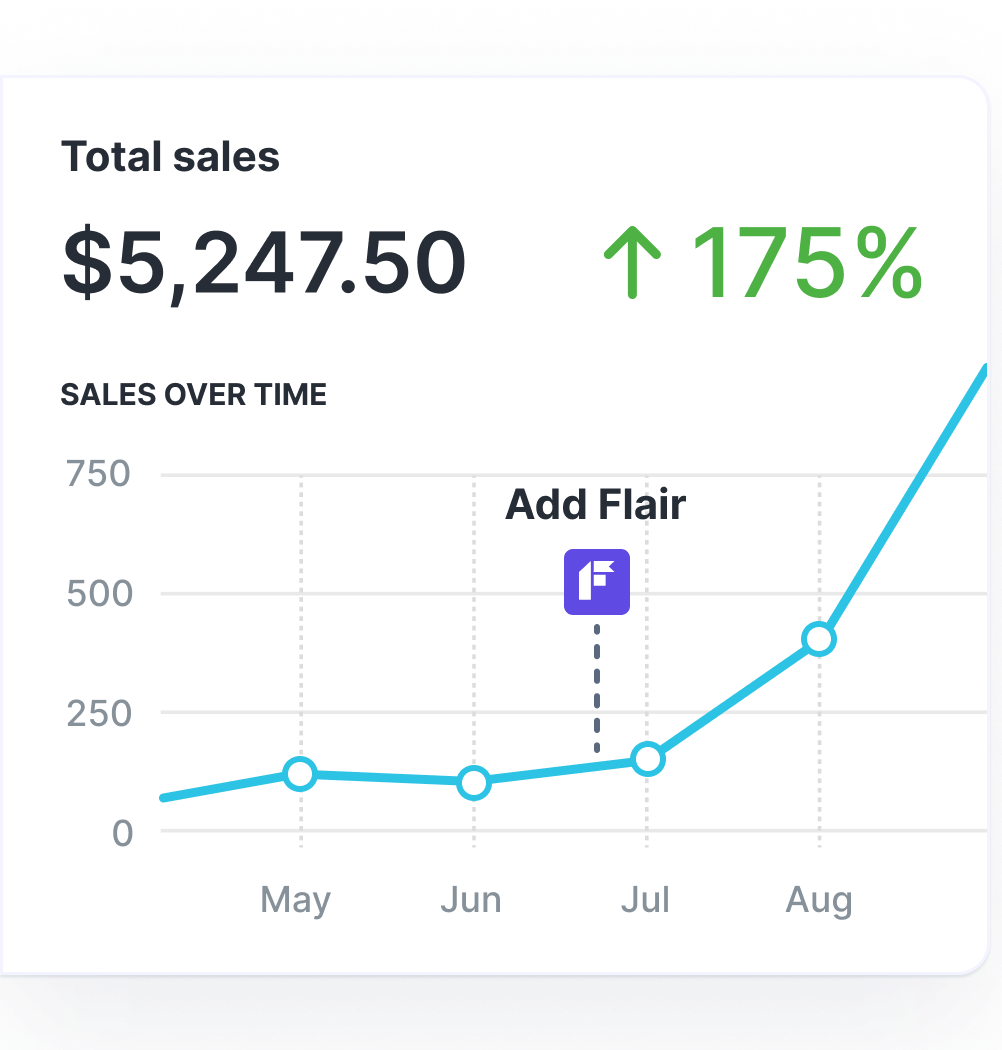
Grow Your Shopify Sales by over 175% with Flair
-
Increase sales using product badges and sales banners
-
Maximize conversions with scarcity, urgency and countdown timers
-
Automate promotions with targeted rules and scheduling



